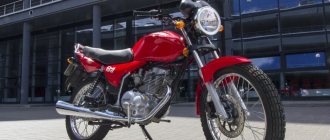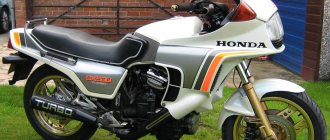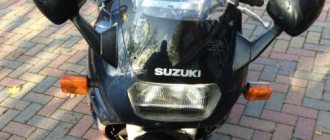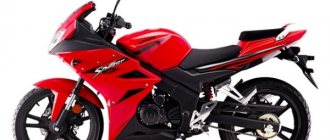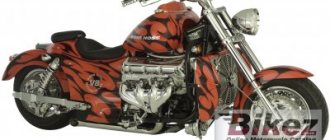Sagitta SBR 150 spitzer review – specifications and prices
The Sagitta SBR 150 Spitzer is a simple motorcycle from a Chinese manufacturer , created on the platform of the more popular Japanese model YamahaYBR 125. The bike differs from its closest competitors, for the most part, in improved technical indicators. But as for its appearance, it is quite mediocre and boring, for a motorcycle produced in 2012.
Exterior design of Sagitta SBR 150
The design of the motorcycle is not particularly attractive.
From the front, the Sagitta SBR 150 Spitzer is very similar to its direct competitor, the StelsSB 200, developed by the Russian manufacturer.
- The head optics of the motorcycle are represented by two oblong-shaped headlights, with four sharp corners, which are located on both sides of the body.
- The turn signal indicators are placed separately, on individual plastic footrests, making them better visible from the side.
Front fairing with headlights and windshield.
Side view with the stock muffler, which by the way gets clogged quickly.
Back view
The rear of the 150 Spitzer looks rather boring : under the wing there is a trapezoid-shaped LED indicator, and under it you can see a small reflector, like on most Chinese scooters.
The turn signal indicators are also placed on separate platforms so that drivers moving behind the motorcycle can better see signals about its maneuver.
Engine
Motorcycle Vespa LX 150 IE and S150 IE 2013 review
Technical characteristics of Vespa LX 150 IE and S150 IE 2013
Engine Vespa LX 150 IE and S150 IE 2013
Transmission Vespa LX 150 IE and S150 IE 2013
Dimensions and weights of Vespa LX 150 IE and S150 IE 2013
Chassis and brakes Vespa LX 150 IE and S150 IE 2013
Dynamic characteristics of Vespa LX 150 IE and S150 IE 2013
Other characteristics of Vespa LX 150 IE and S150 IE 2013
Description Vespa LX 150 IE and S150 IE 2013
The description of the Vespa LX 150 IE and S150 IE 2013 motorcycle is in the queue for publication of the article. Announcement: Today, for almost every new motorcycle that comes into being, marketers strive to carve out their own niche. This one is a road sport, this one is a recreational enduro. But what class should we include a motorcycle that has a little bit of everything? A good bike should have a reliable engine, comfortable ergonomics and simple controls.
Despite the fact that good models of motorcycles have a very respectable price, and the season for their use is relatively short, the motorcycle market is developing rapidly. And if you believe the words of dealers, then some models of recently released motorcycles are selling like hot cakes at the beginning of the season, and the models brought to Russia are clearly not enough to fully satisfy consumer demand.
A motorcycle has long ceased to be an alternative to a car, and the times when this equipment was bought only because there was not enough money for a full-fledged car are forgotten. Nowadays, two-wheelers can be called technological marvels in many cases, and their cost can be compared with that of prestigious cars.
Many people have started buying motorcycles for hobby purposes as riding or even collecting them has become a good pastime for many people. Many motorcycles, for example Vespa LX 150 IE and S150 IE whose technical characteristics allow the model to be called a prestigious brand, are in demand among both beginners and experienced motorcyclists.
Motorcycles with an engine capacity of 150 cc / 9.2 cu in. see, appeared as a result of long work of inventors who sought to create a model that was not inferior in characteristics to other versions of the motorcycle. In some cases, these models are not only not inferior, but also ahead of other motorcycles, as they have minimal fuel consumption and other excellent parameters.
Vespa LX 150 IE and S150 IE belong to a common class of motorcycles with engine capacity from 125 to 250 kb. cmAs a rule, these are light and relatively low-power motorcycles. Here you will get flexible control, easy steering and low weight of the motorcycle. Therefore, such motorcycles are suitable for almost every beginner, regardless of their characteristics. The exception is motorcycles with two-stroke engines of the “sport” and “cross” classes, since bikes of this class are distinguished by more power and an extremely sharp response to the throttle, which also does not make them obedient to control.
Go to the entire range of Vespa motorcycles, on this page you can find Vespa LX 150 IE and S150 IE motorcycles from other years of production and information about them
Price of Vespa LX 150 IE and S150 IE according to sales advertisements
* Attention! Under the maximum, average and minimum of the Vespa LX 150 IE and S150 IE motorcycle on this page, the average cost according to advertisements for sale on the Internet is indicated, without taking into account the year of manufacture, configuration and generation of the motorcycle model.
Five random motorcycles:
Five random articles about motorcycles:
Java 680 Trial (250 cc)
Jawa-680 250 cc for trial Among fans of motorcycle sports, there are more and more people who are fond of trials. Accordingly, the share of trial machines in the global production of sports motorcycles is growing. Now they are made by such factories as the Italian "Aprilia", "Beta", "Garelli", the Japanese "Honda", "Simson" - in the GDR, ChZ and JAVA - in Czechoslovakia. One of the largest manufacturers of sports motorcycles, Italian, annually produces 5,000 machines specially designed for such competitions. On the scale of Western Europe, this is a rather impressive figure. YAVA-680 is a special motorcycle of the 1987 model. The engine with a displacement of 246 cm3 with a cylinder diameter of 70 mm and a piston stroke of 64 mm is a further modification of the YAVA-125 engine. When creating it, the goal was to ensure minimal external dimensions and weight. The cylinder is made of an alloy of light metals, a mixture of r.
Java 250 Trial – Jawa 250 Trial
A trial for everyone Jawa 250 Trial The design of the motorcycle Jawa 250 Trial The Trial is a motorcycle competition for cross-country driving skills that is gaining more and more popularity in the world. At the FIM congress, the issue of making trials the number one discipline in the international motorsports calendar and recommending it to the Olympic Games program was even discussed. In mass trials competitions, excluding official meetings held under the auspices of the FIM, ordinary road motorcycles are used. The modifications boil down to protecting the engine from below, reducing the fork travel and adjusting the motor to achieve maximum power in the first two or three gears (speed does not matter here). At the same time, leading foreign motorcycle companies began producing special machines for trials. The Czechoslovak JAVA plant in Prague is also starting to produce such motorcycles. The design of the Jawa 250 Trial motorcycle takes into account the specifics determined by the competition route. The chassis is provided by the poppy.
New. IZh Planet-Sport
Discovery of a new planet Short press reports about the creation of a new motorcycle at the famous Izhevsk Machine-Building Plant, the country's largest manufacturer of two-wheeled vehicles, aroused the natural interest of motorcyclists. Evidence of this is numerous letters to the editor with a request to talk in detail about the new IZh on the pages of the magazine. While testing and fine-tuning the design of the machine were underway, the plant was preparing for its production. And at the end of last year (1973) the first IZh Planet-sport motorcycles appeared. This event is significant not only for the plant, but also for the domestic motorcycle industry - we have a new type of motorcycle, not inferior to most foreign models. It is called a road sports car because it has the qualities of both a road car and a sports car. From the first he inherited the equipment necessary when driving in traffic, convenience for the driver and passenger on long trips, efficiency, ease of maintenance and repair, r.
Tips for modifying the Dnepr MT10-36 motorcycle. What is Dnieper missing?
Tips for modifying the Dnepr MT10-36 motorcycle It so happened that my first motorcycle was the Dnepr MT10-36. I bought it second hand with a mileage of about 3 thousand kilometers. Probably the previous owner had had more than enough trouble with it in such a short time, but then I didn’t attach any importance to it. As does the fact that the motorcycle was released at the end of December 1979. The study of the motorcycle and the fight against its defects, both congenital and acquired, took place during the process of operation. And the deeper I delved into the device, the more surprised I was at the imperfection of the design. Gradually, I gained experience in treating typical diseases. I shared this experience with friends and acquaintances - they liked it. Now I decided that I could reach a wider audience. By the way, I made several attempts to establish a direct connection with the Kyiv motorcycle plant in the hope of getting the designers interested in my observations. The idea was exactly half a success: the connection was established, and what about Zain.
Device for disassembling the shock absorber of the rear suspension of the Dnepr motorcycle
To disassemble the shock absorber Repair of the rear suspension shock absorber on the Dnepr motorcycle begins with dismantling the outer casing. This operation is only possible if you first compress the spring under the casing and remove the crackers 5 (see figure). For this purpose, I use the simplest device consisting of an annular cage 3, an axis 2 and two bolts 1. All parts with dimensions are shown in the figure. We remove the silent block from the upper eye of the shock absorber, place the device clip on top of the casing, insert the axle into the eye and screw the bolts into it until they stop into the special recesses on the clip. Tightening the bolts one by one, we compress the spring until the crackers 5 are released. We remove the crackers from the socket and, by unscrewing the bolts from the axle, release the casing and spring. V.VASKOV Kostroma region, Neya Device for disassembling the shock absorber of the rear suspension of the Dnepr motorcycle: 1 - M8 bolt (2 pcs.); 2 - axis; 3 — clip; 4 — upper suspension eye.
MY MOTORCYCLE
The Chinese motorcycle industry surprises with its versatility.
For each country where their motorcycles are sold, they can do whatever you want. And what’s most interesting is that the same bike can have different names and, possibly, some differences. One of these bikes can be called the Sagitta Spitzer 150 motorcycle. The fact that it is Chinese is clear to a fool and it has twins: Patron Sport 150, Stels SB200, Loncin LX150-30. Especially the last option is the same bike, but released under a different brand. Although Loncin can boast that it ranks second in the Chinese ranking with 2.5 million annual production of motorcycles and 3 million engines (including producing engines for the BMW G650GS model). I think vipers will have similar tricks!) But let’s return specifically to our motorcycle: as far as they write about it (I found a small review), the device is thought out quite well, especially since it is made according to the prototype of the popular KYMCO Quannon 125 model (except for the motor).
The design of the Sagitta Spitzer 150 motorcycle is not particularly interesting or remarkable. Fairing corners are a bit sharp. Again, I repeat that it is no different from Chinese bikes under a different name. But the assembly is not terrible either))) The mirrors have normal visibility but do not match the dimensions of the steering wheel a little - they are 160 mm wider than the steering wheel. There is also no kickstarter. The side stop does not fire off under the action of the spring, but there is a sensor that prevents the engine from starting. The passenger seat cushion is also removable (if you unlock it with the ignition key), and there is room for a tool.
I wouldn’t say that this device still belongs to the class of sport bikes, although the design is “kinda suitable.” It is much more comfortable on the highway than in city traffic jams. And the educational “figurine” fits the “classics” much better. There is a meager ground clearance - only 150 mm. Even a low curb readily comes into contact with the fairing beak.
Now let's turn our attention to the power unit of the motorcycle. As the guy wrote after the test drive: “To start, I had to turn on the enricher, then stand / warm up the engine. After waiting about three minutes, I began to remove the enrichment agent, but the engine stalled. At least it seemed so to me, and I already began to get angry with the salon workers: couldn’t they adjust the idle speed? Imagine my surprise when it turned out that the engine did not stall: at idle speed (a little over a thousand) the sound is so quiet that it cannot be heard in the noise of the street. But when driving, it sounds as if there are 600 cubic meters in the cylinder, no less.”
Actually, the engine is a widespread clone of the Honda CG series unit, which the Japanese discontinued in 2008. Its feature is a lower camshaft with one cam and a rod drive of two valves in the cylinder head. But while driving, the engine will not show you mega power and traction. Although what can you want from 150 cubes (as I say “Chinese macaque”). I don't understand those weirdos at all. What do they want from such spendthrifts with super performance and other crap? Although the fifth (highest) gear can be engaged already at 45 km/h. By the way, more modern Chinese engines have acquired a six-speed gearbox, but the unit itself is more complex (it is liquid-cooled), and it is not yet clear what its reliability and, most importantly, the availability of spare parts are. Although, on the other hand, we now have a lot of all sorts of rubbish for Chinese hoes.
A well-functioning “segeshka” is as reliable as a Kalashnikov assault rifle. The maximum that the engine is capable of is 9500 rpm, while the rumble from the muffler turns into a howl, but not as frightening as on real sports bikes, when it seems that just a little more and the pistons will fly into the stratosphere. At these speeds, the speed declared by the manufacturer is actually achieved - 110 km/h. But it’s uncomfortable to drive, it’s better to keep it at 80-85. And you shouldn’t expect more.)))) But there seems to be no special vibrations from the engine at speed, although the engine does not have a balancer shaft.
In general terms: the engine still “turns”, although in theory it shouldn’t: the valve timing is due to one cam - without overlap. At the same time, he doesn’t want to drive into second at low speed, he demands to switch!
By the way, its instrumentation is quite good - a combination of LCD technologies with a classic dial tachometer. The speed numbers are displayed large and are perfectly readable, as is the number of the gear engaged.
By the way, the speedometer is completely electronic: there is a magnet on the hub, and a wire from the sensor (goodbye, ancient cable!). The odometer is made in two digital lines (the second is the mileage counter, which is reset each time the engine is turned off). But it is especially convenient that there is a fuel gauge, and its calibration is almost linear. But there are minor drawbacks: the control lamps are not bright enough: the “neutral” and “flashing lights” indicators are not visible in strong sunlight. Halogen headlights are clearly visible in the mirrors. The loud exhaust also warns drivers - most immediately move away.
Both disc brakes are “dead,” at least from the speeds to which the 11-horsepower engine can accelerate the device. True, the rear brake pedal may seem flimsy and also very low. However, its position can be adjusted. Reinforced brake hoses also contribute to active safety. The suspensions really work, you can feel the fluid dampening vibrations. The rear monoshock, directly connecting the swingarm and frame, has a threaded spring preload adjustment. The setting can only be changed using the appropriate keys; they are not included in the standard set. But it’s not just the suspension that provides comfort; the seats also play a role in this. They are made separately, with the rear one raised, as is customary on sportbikes. Both cushions are spartan, and after a long non-stop ride, the butt can slowly become “iron”))))
Overall, the motorcycle is pretty good, as an alternative to expensive ones when you don’t have much money. The Sagitta Spitzer 150 motorcycle is catchy, comfortable, and the dynamics are even higher than you expect from a 150 cc. It is not recommended to learn to drive in one, but for short trips on good roads it is just right. In principle, as on all motes of such formats))). True, given that the concept of a sportbike usually implies both image and power components, not everyone will agree to sacrifice them for the sake of a tempting price tag.

